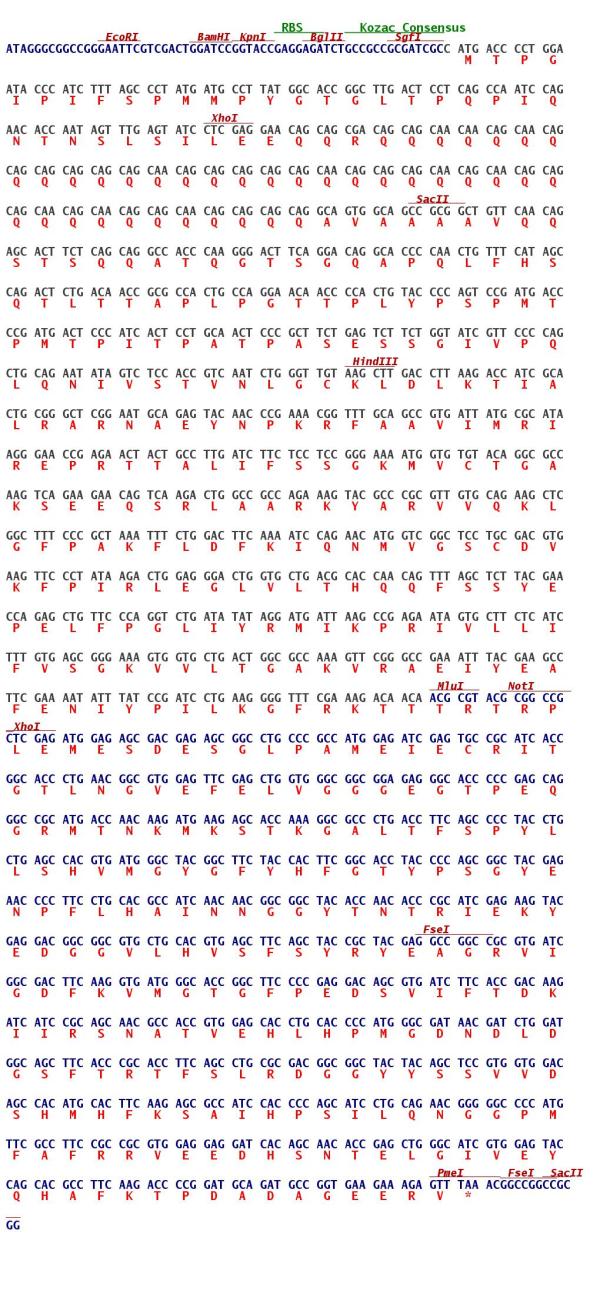TATA binding protein (TBP) (NM_001172085) Human Tagged ORF Clone
SKU
RG229881
TBP (tGFP-tagged) - Human TATA box binding protein (TBP), transcript variant 2. Note: ORF is codon optimized
-
TrueORF®
TrueORF®
Expression-ready ORF plasmid with C-terminal tag(s)
Click here to learn more.
| Product Data | |
| Type | Human Tagged ORF Clone |
|---|---|
| Target Symbol | TATA binding protein |
| Synonyms | GTF2D; GTF2D1; HDL4; SCA17; TFIID |
| Vector | pCMV6-AC-GFP |
| E. coli Selection | Ampicillin (100 ug/mL) |
| Mammalian Cell Selection | Neomycin |
| Sequence Data |
ORF Nucleotide Sequence
>RG229881 ORF sequence, codon optimized.
Due to the complexity of NM_001172085, the ORF clone is codon optimized for mammalian Expression. The nucleotide sequence differs from the reference sequence, yet the amino acid sequence remains identical. Red=Cloning site Blue=ORF Green=Tags(s) TTTTGTAATACGACTCACTATAGGGCGGCCGGGAATTCGTCGACTGGATCCGGTACCGAGGAGATCTGCC GCCGCGATCGCC ATGACCCCTGGAATACCCATCTTTAGCCCTATGATGCCTTATGGCACCGGCTTGACTCCTCAGCCAATCC AGAACACCAATAGTTTGAGTATCCTCGAGGAACAGCAGCGACAGCAGCAACAACAGCAACAGCAGCAGCA GCAGCAGCAACAGCAGCAGCAGCAGCAACAGCAGCAGCAACAGCAACAGCAGCAGCAACAGCAACAGCAG CAACAGCAGCAGCAGGCAGTGGCAGCCGCGGCTGTTCAACAGAGCACTTCTCAGCAGGCCACCCAAGGGA CTTCAGGACAGGCACCCCAACTGTTTCATAGCCAGACTCTGACAACCGCGCCACTGCCAGGAACAACCCC ACTGTACCCCAGTCCGATGACCCCGATGACTCCCATCACTCCTGCAACTCCCGCTTCTGAGTCTTCTGGT ATCGTTCCCCAGCTGCAGAATATAGTCTCCACCGTCAATCTGGGTTGTAAGCTTGACCTTAAGACCATCG CACTGCGGGCTCGGAATGCAGAGTACAACCCGAAACGGTTTGCAGCCGTGATTATGCGCATAAGGGAACC GAGAACTACTGCCTTGATCTTCTCCTCCGGGAAAATGGTGTGTACAGGCGCCAAGTCAGAAGAACAGTCA AGACTGGCCGCCAGAAAGTACGCCCGCGTTGTGCAGAAGCTCGGCTTTCCCGCTAAATTTCTGGACTTCA AAATCCAGAACATGGTCGGCTCCTGCGACGTGAAGTTCCCTATAAGACTGGAGGGACTGGTGCTGACGCA CCAACAGTTTAGCTCTTACGAACCAGAGCTGTTCCCAGGTCTGATATATAGGATGATTAAGCCGAGAATA GTGCTTCTCATCTTTGTGAGCGGGAAAGTGGTGCTGACTGGCGCCAAAGTTCGGGCCGAAATTTACGAAG CCTTCGAAAATATTTATCCGATCCTGAAGGGGTTTCGAAAGACAACA ACGCGTACGCGGCCGCTCGAG - GFP Tag - GTTTAA
Protein Sequence
>RG229881 representing NM_001172085
Red=Cloning site Green=Tags(s) MTPGIPIFSPMMPYGTGLTPQPIQNTNSLSILEEQQRQQQQQQQQQQQQQQQQQQQQQQQQQQQQQQQQQ QQQQQAVAAAAVQQSTSQQATQGTSGQAPQLFHSQTLTTAPLPGTTPLYPSPMTPMTPITPATPASESSG IVPQLQNIVSTVNLGCKLDLKTIALRARNAEYNPKRFAAVIMRIREPRTTALIFSSGKMVCTGAKSEEQS RLAARKYARVVQKLGFPAKFLDFKIQNMVGSCDVKFPIRLEGLVLTHQQFSSYEPELFPGLIYRMIKPRI VLLIFVSGKVVLTGAKVRAEIYEAFENIYPILKGFRKTT TRTRPLE - GFP Tag - V |
| Restriction Sites |
SgfI-MluI Cloning Scheme for this gene
Plasmid Map

|
| ACCN | NM_001172085 |
| ORF Size | 957 bp |
| OTI Disclaimer | Due to the inherent nature of this plasmid, standard methods to replicate additional amounts of DNA in E. coli are highly likely to result in mutations and/or rearrangements. Therefore, OriGene does not guarantee the capability to replicate this plasmid DNA. Additional amounts of DNA can be purchased from OriGene with batch-specific, full-sequence verification at a reduced cost. Please contact our customer care team at custsupport@origene.com or by calling 301.340.3188 option 3 for pricing and delivery. The molecular sequence of this clone aligns with the gene accession number as a point of reference only. However, individual transcript sequences of the same gene can differ through naturally occurring variations (e.g. polymorphisms), each with its own valid existence. This clone is substantially in agreement with the reference, but a complete review of all prevailing variants is recommended prior to use. More info |
| OTI Annotation | This clone was engineered to express the complete ORF with an expression tag. Expression varies depending on the nature of the gene. |
| Components | The ORF clone is ion-exchange column purified and shipped in a 2D barcoded Matrix tube containing 10ug of transfection-ready, dried plasmid DNA (reconstitute with 100 ul of water). |
| Reconstitution Method | 1. Centrifuge at 5,000xg for 5min. 2. Carefully open the tube and add 100ul of sterile water to dissolve the DNA. 3. Close the tube and incubate for 10 minutes at room temperature. 4. Briefly vortex the tube and then do a quick spin (less than 5000xg) to concentrate the liquid at the bottom. 5. Store the suspended plasmid at -20°C. The DNA is stable for at least one year from date of shipping when stored at -20°C. |
| Note | Plasmids are not sterile. For experiments where strict sterility is required, filtration with 0.22um filter is required. |
| Shipping | Ambient |
| Reference Data | |
| RefSeq | NM_001172085.1, NP_001165556.1 |
| RefSeq Size | 1719 bp |
| RefSeq ORF | 960 bp |
| Locus ID | 6908 |
| UniProt ID | P20226 |
| Cytogenetics | 6q27 |
| Protein Families | Druggable Genome, Transcription Factors |
| Protein Pathways | Basal transcription factors, Huntington's disease |
| Summary | Initiation of transcription by RNA polymerase II requires the activities of more than 70 polypeptides. The protein that coordinates these activities is transcription factor IID (TFIID), which binds to the core promoter to position the polymerase properly, serves as the scaffold for assembly of the remainder of the transcription complex, and acts as a channel for regulatory signals. TFIID is composed of the TATA-binding protein (TBP) and a group of evolutionarily conserved proteins known as TBP-associated factors or TAFs. TAFs may participate in basal transcription, serve as coactivators, function in promoter recognition or modify general transcription factors (GTFs) to facilitate complex assembly and transcription initiation. This gene encodes TBP, the TATA-binding protein. A distinctive feature of TBP is a long string of glutamines in the N-terminus. This region of the protein modulates the DNA binding activity of the C terminus, and modulation of DNA binding affects the rate of transcription complex formation and initiation of transcription. The number of CAG repeats encoding the polyglutamine tract is usually 25-42, and expansion of the number of repeats to 45-66 increases the length of the polyglutamine string and is associated with spinocerebellar ataxia 17, a neurodegenerative disorder classified as a polyglutamine disease. Two transcript variants encoding different isoforms have been found for this gene. [provided by RefSeq, Jul 2016] |
Write Your Own Review
| Product Manuals |
| FAQs |
| SDS |
Citations
*Delivery time may vary from web posted schedule. Occasional delays may occur due to unforeseen
complexities in the preparation of your product. International customers may expect an additional 1-2 weeks
in shipping.



